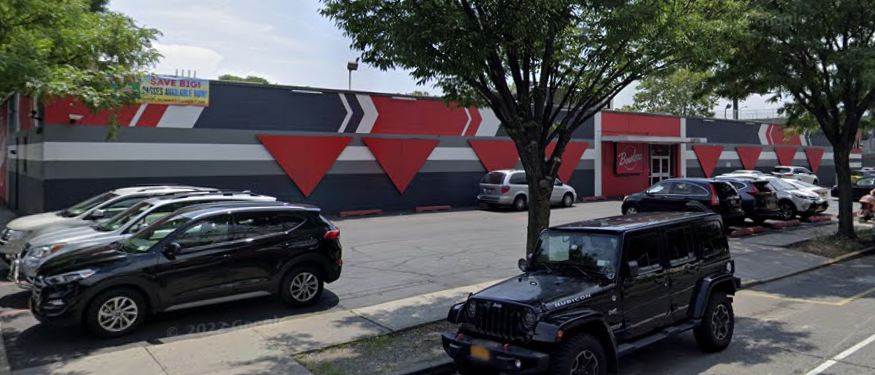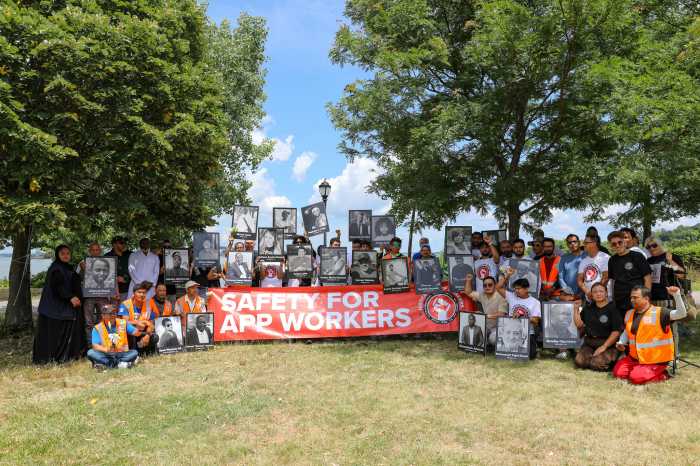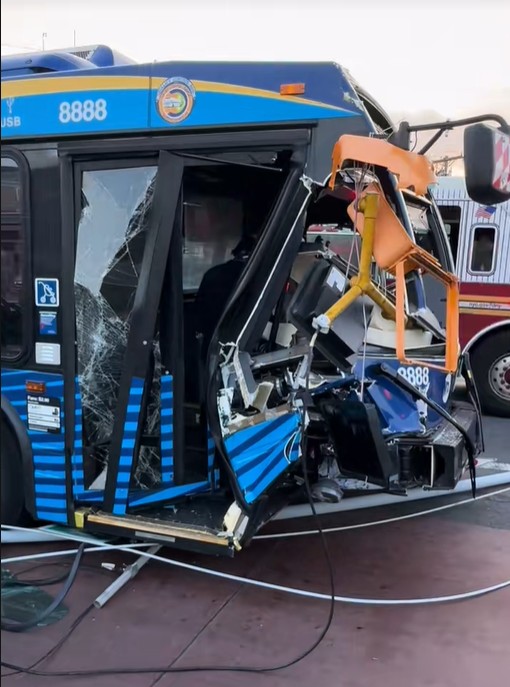Claim Busier L.I.C. Facility Would Bring Pollution
Several local lawmakers joined together at a Monday, July 2 press conference in front of Waste Management’s Long Island City waste transfer station, claiming that the state’s decision to allow the company to expand the facility’s use would result in an increase in noise pollution and foul odors throughout the area.

State Senators Joseph Addabbo and Michael Gianaris joined Assemblyman Mike Miller, City Council Member Elizabeth Crowley, local merchants, residents and members of the Juniper Park Civic Association (JPCA) at the driveway of 38-22 Review Ave., claiming that the granting of a state Department of Environmental Conservation (DEC) permit for the facility would allow it to process double the amount of trash.
“These residents don’t need more rail bothering them on a daily basis,” said Addabbo, “because when you talk about more rail, you’re talking about coupling and idling and braking,” which would increase the noise pollution in the area.
Addabbo pointed to a letter from the DEC to a local resident, Anthony Pedalino of Middle Village, that admits an increase in rail cars and noise through the area. The letter also claims that odors would not be increased significantly.

“Well, I beg to differ,” the lawmaker said. “I think any increase in noise and odor pollution is too much for these residents.”
“There is no good reason why this one small part of Queens should be bearing a disproportionate share of the burden for dealing with the city’s garbage,” Gianaris claimed, adding that “to suggest that we can double the amount of garbage coming through would be no difference in this location without affecting the odor is on its face laughable.”
“It’s not fair to our residents,” Miller claimed; “we’re not going to stand by and take this any longer.”
Crowley added that “this burden has been going on for far too long,” with odor and noise affecting residents in her Council district, as well as air pollution leading to asthma issues for those in the area.
“These problems are already existing, and now the DEC and the Department of Sanitation want to make matters worse for our community? We’re here to unite together and say no,” Crowley said. “This plan stinks.”
Pedalino, who lives near the CSX rail line, claimed that some residents live so close that they are unable to open their windows.
“In the last five years, it has recently worse,” he said, adding that with the increase in traffic, “it’s going to be completely intolerable, with no option for remedying the noise.”
Nick Sherman, the vice president of William E. Williams Valve Corp., claimed that their business, located next door to the Waste Management plant, would suffer with the increase.
Sherman noted that he and other business owners paid for a study in 2010 of the impact of the DEC decision on the area in an attempt to determine whether Waste Management was correct in issuing a “negative declaration” which claimed that no study was necessary.
“I don’t see how 210 trucks going down an alley that’s not even wide enough legally for two-way traffic shouldn’t be looked at,” said Sherman.
According to the study, prepared by the law firm of Zarin & Steinmetz, the DEC’s “failure to openly discuss and evaluate reasonable alternatives to the project such as a truck-to-barge option, take a ‘hard look’ at the potential significant impacts from the project, including the impacts to the residents of Maspeth from the activi- ties proposed at the Maspeth Rail Yard, the use of stale and often questionable data, and an outright preclusion of any open meaningful public or other governmental input, makes any consideration of the issuance of a negative declaration on this application inappropriate and clearly illegal.”
The plan
As previously reported in the Times Newsweekly, the DEC gave its blessing to Waste Management on June 11 to expand the facility to accommodate the shipment of municipal waste collected by the Sanitation Department from areas within the confines of Queens Community Boards 1 through 6, covering the area from Astoria to Forest Hills.
Reportedly, this would increase the amount of sanitation trucks the facility handles from 90 to 210 a day.
The expansion is part of the Solid Waste Management Plan approved by New York City in 2010, which it was noted is designed to make each borough responsible for its own waste disposal.
Under the permit, the company will be able to “increase its storage capacity and transportation of container cars” filled with solid waste by truck from the station through a private roadway to the nearby Blissville Rail Yard. The site can hold up to 40 container cars.
From there, the trash containers will be loaded onto freight rail cars, then shipped south along the Long Island Rail Road’s (LIRR) Montauk branch to the Fresh Pond Railyard in Glendale.
According to JPCA President Robert Holden, the cars will then take “a tour of New York State,” traveling across the Hell Gate Bridge to Selkirk, N.Y. (about eight miles south of Albany) to cross the Hudson River before traveling south to New Jersey and eventually to a processing facility in Virginia.
“I don’t think that makes much sense when you consider this facility … is sitting on the Newtown Creek, a waterway,” said Holden, who claimed that the JPCA and CURES- Civics United For Railroad Environmental Solutions, an umbrella group of civic groups of which the JPCA is a member- has urged the DEC to consider barging the waste from the station to Port Elizabeth or Port Newark in New Jersey via the Newtown Creek.
“The state DEC is supposed to protect the environment,” said Holden. “I don’t think this is protecting the environment with diesel trains.”
Waste Management has previously claimed that barging the waste is not feasible; at a June 15, 2009 meeting when the plans for the plant were unveiled, the company claimed that they would need to triple the proposed volume of trash the plant would process to make using waterways financially viable.
Addabbo noted that legislative remedies are “complex” due to the myriad federal regulations involving the shipment of freight.
Legislation introduced last year that would require the rail cars to be sealed failed in the State Senate. Addabbo claimed that pressure from CSX, the company that would be responsible for the rail transport, killed the bill.
“CSX and other rail companies are big contributors to some of my senators, who would rather accept their contributions than do the right thing,” he told the Times Newsweekly, adding that the bill was on track for passage in 2010 until “our mayor called the Republican conference and actually switched some votes from yes to no.”
Addabbo added that he planned to reintroduce the bill in the next legislative session.
The DEC has claimed that the rail cars would be sealed.



































